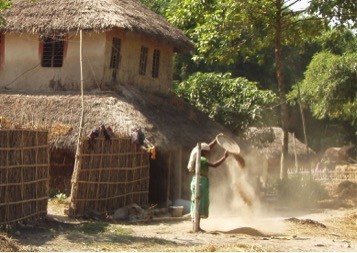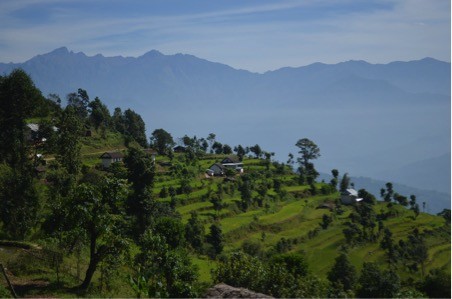Feminization of agriculture – opportunity or burden? Polarized lessons from Nepal
It’s a longstanding debate as to whether men’s declining role in agriculture is a challenge or an opportunity for rural women. But it is clear that the role of women in South Asia’s agricultural sector is changing as the so-called feminization of agriculture unfolds.
One interpretation highlights the substantial opportunities available for women. Women suddenly have control over finances, including lucrative flows of income from off-farm labor or remittances. But at the same time, there are challenges. The crippling workload shouldered by women when men are absent has been raised in numerous studies from the region. It’s also been noted that feminization can produce substantial challenges when women take on new roles, yet do not have access to the same range of assets as their male counterparts.
Intersectionality of gender roles in Nepal
While the narratives of agricultural feminization are increasingly polarized, there is still a dearth of studies that seek to make sense of this diversity of experiences. One underlying reason is the persistent failure to meaningfully engage with the more highly politicized issues of inequality—grounded in class and ethnicity—that interact with gender. These interactions and interlinkages are known in gender studies as ‘intersectionality’.
One cannot understate the importance of agrarian relations—historical, political, economic factors of rural life—in countries such as Nepal in shaping both the livelihood outcomes at a household level as well as the opportunities for women and experiences of feminization within the household.
The tale of two communities in the Tarai Madhesh, southern Nepal
Agrarian inequality in Nepal is grounded in historic tax collection and land ownership hierarchies dating back to the 18th century. Attempted land reforms in the 1960s ultimately failed to make significant headway, and today a large proportion of urban and rural land is owned by politically influential landlords, many of whom have links to the power structures of Kathmandu.
Vast parts of the eastern Tarai-Madhesh in southern Nepal are still under landlordism, particularly in the domains East of the Koshi River, which is home to a significant indigenous (Tarai janajati) and Dalit population. Driven by limited opportunities in agriculture as well as rising costs of living, climatic stress, and transforming aspirations of youth, the livelihoods of a majority of farmers increasingly straddle both the peasant and capitalist economy. Many working-aged men migrate to find work elsewhere or engage in casual off-farm labor.

Bhaudaha is a village that lies in the fertile and lush plains of southern Morang, a densely populated and culturally diverse region to east of Biratnagar, Nepal’s third biggest city. Up to 75-80% of the land in this village is under tenancy. The historically marginalized indigenous Rajbanshi and Bantar cultivate the land, yet give away 50% of the harvest as rent to absentee landlords in Biratnagar and even Kathmandu.
These tenants have few opportunities to accumulate wealth, and male out-migration is an essential safety valve. Many men also increasingly seek work in the city as casual laborers in construction or factories. In this context, women shoulder a significant burden. They are responsible for all on-farm labor as well as for household tasks.
Food insecurity is a persistent concern, and few have access to surplus cash. Even accessing irrigation for dry season cultivation is a challenge, given the gender barriers faced by women in negotiating for water. The indifference of landlords to improve the land by installing tube wells and providing pump set – equipment that is out of reach for marginal tenants – is also a barrier. Many women are responsible for repaying the debts incurred for sending family members overseas. This adds to economic insecurity and eats into the remittance inflows.
Further north, toward the East-West Highway, is a belt of more recently settled land, cleared from the jungle over the past 50 years. Given the recent history of settlement, the area has not suffered under the historic feudal tax system, and with a greater availability of land, landlordism is a less prevalent problem.
In these northern villages, the signs of prosperity are evident in the larger houses with tin roofs, well-organized village administrations and fertile, well-irrigated fields. Many farmers are upper castes, who migrated from the hills; others are from the indigenous Tharu or Khawas communities.
Here, out-migration is also common, although the situation for the women who stay behind is very different. Many households have plots of up to one hectare, which is sufficient to support a family of six for most of the year. With higher levels of education, many migrants from this area have received semi-skilled or more lucrative jobs in the Gulf States, and the resulting remittance flows are higher and indebtedness is lower. Aside from the higher flows of cash, the women who stay behind often are not shouldering the same work burden. One woman in the village of Haraicha had hired laborers (often from poorer tenant farmers) to cope with the labor shortage when men migrate, and had even invested some cash in a poultry business. Others make use of labor-saving technologies, such as tractors and threshers.
Thus, despite being located within the same part of the country, women in these two communities face vastly different realities due to a host of complex factors, including the historical context, their caste and socio-economic class.
Further north, in the hills, an even more complex history of exclusion of certain indigenous communities has contributed to unique gender outcomes in diverse agro-ecological zones. Similar differences in gendered experiences are evident in studies across the region.

Larger social structures govern the role of women
In sum, it is clear that women farmers do not have a universal experience of feminization, although agricultural extension agencies, researchers and development institutions have often failed to fully grasp this complexity. Often, positive or negative case studies are heralded to inform policy, without understanding the political-economic structures behind them.
Nepal itself is emerging from a prolonged political transition and rewriting of the disputed constitution, driven in part by long-standing ethnic, caste and class inequalities. In this context, engaging with gender through the prism of larger social structures is a necessity, not simply a field of academic curiosity.
Nevertheless, promising leads, such as the effort to set up micro-level farmer collectives, have attempted to address the intersectionality of poverty and gender inequality that has long shaped development outcomes in this part of South Asia. Such innovative initiatives that look beyond gender and consider larger dynamics in society may be rural Nepalese women’s best bet for more equitable futures.
#
Thrive blog is a space for independent thought and aims to stimulate discussion among sustainable agriculture researchers and the public. Blogs are facilitated by the CGIAR Research Program on Water, Land and Ecosystems (WLE), but reflect the opinions and information of the authors only and not necessarily those of WLE and its donors or partners. WLE and partners are supported by CGIAR Fund Donors, including ACIAR, DFID, DGIS, SDC, and others.



Add new comment